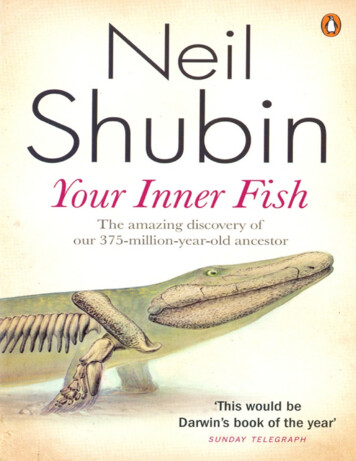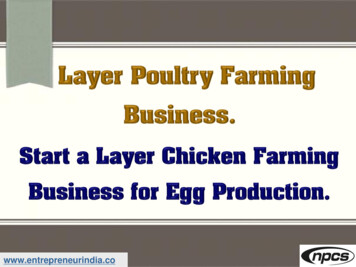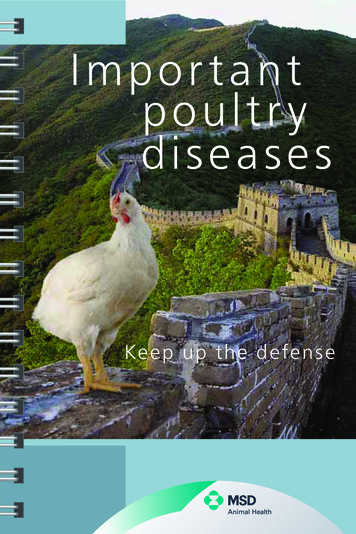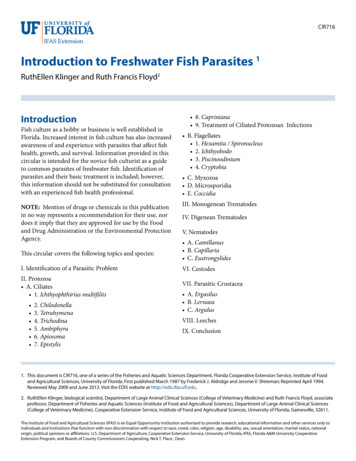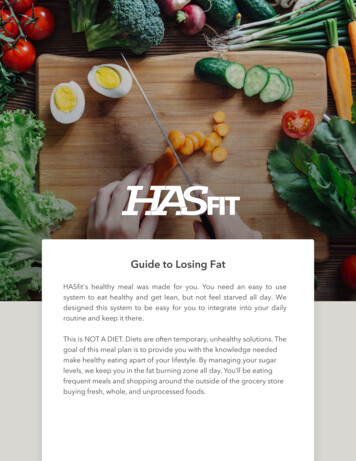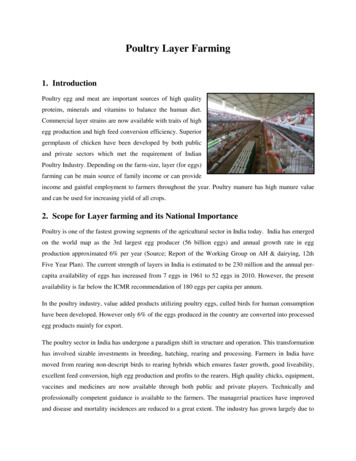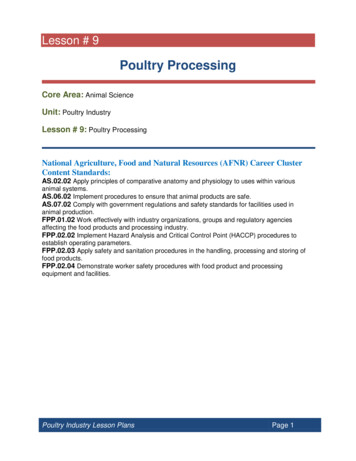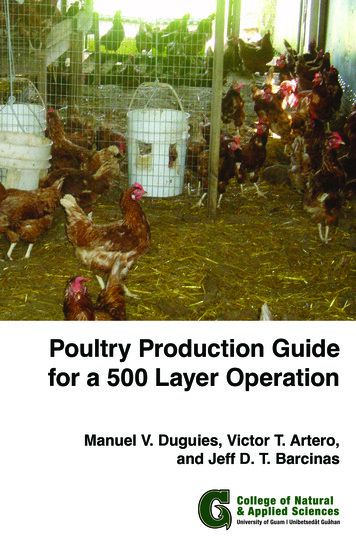
Transcription
12Meats, Poultry, and FishCHAPTER OUTLINEOBJECTIVESObjectivesClassificationFood For Thought: Fish and the EnvironmentStructureMuscle Tissue Connective Tissue FatPigmentsMyoglobin and Related Compounds Changes Effected by Heating ChangesEffected by CuringMeat QualityFactors Affecting Quality Inspection and GradingIdentifying Meat CutsMarketingFresh/FrozenFood for Thought: Kosher/HalalDomestic/ForeignIngredient Insights: Apples and an Antimicrobial Edible FilmCarcass/Case-ReadyFood for Thought: Shrimp AhoyPreparationChanges Effected by Heat Effects of Altering pH Effect of Salt Meat TenderizersModified Meat ProductsReduced-Fat Meats Restructured MeatsComminuted Meats Structured Seafood ProductsSoy ProteinProducts Using Textured Soy Protein Quorn Food for Thought: Petri Burgers?GelatinComposition PropertiesSummaryStudy QuestionsBibliographyMeatRed meats, including beef,veal, pork, and lamb.After studying this chapter, you will be able to:1. Describe the structure and composition of muscle, connective tissue, and fat.2. Identify the pigments in meat and the changes that occurduring heating and cutting.3. Discuss the factors determining meat quality.4. Identify meat cuts, grades, and the marketing process.5. Explain the methods of meat cookery and the rationale forusing each.6. Identify various modified meat products.7. Explain the composition of gelatin and its properties.CLASSIFICATIONFlesh foods usually are categorized as meat, poultry, or fish.Meat includes all red meats from animal sources, althoughthe only ones commonly available are beef, veal, pork, andlamb (or mutton in some countries). Poultry is the inclusiveterm for turkey, chicken, and duck, as well as pheasants andother less available fowl. Fish, in the broad sense, designatesaquatic animals, but frequently it is the more narrow classification that includes only fish with fins, gills, a backbone, anda skull. Shellfish, the other classification of aquatic animals,is subdivided into mollusks and crustaceans, the formerhaving a shell and the latter a horny covering.FOOD FOR THOUGHTFish and the EnvironmentThe public has heard the message of the health benefitsof omega-3 fatty acids, which are found in abundance inseafood. Increased consumption of these fish has c reatedconcern about overfishing of various popular fish, andlimits have been placed on the take for both commercialand sport fishermen. Nature also plays a significant role indetermining when and where seafood will thrive. Water(Continued)253M12 MARG4581 08 SE C12.indd 25312/10/15 1:47 PM
254 Part 4ProteinsPoultryFowl, notably turkey,chicken, and duck.FishBroadly defined as aquaticanimals, but more narrowlydefined to designate thosewith fins, gills, a backbone,and a skull.ShellfishSubclassification of fish;includes mollusks and crustaceans.MollusksShellfish with a protectiveshell.CrustaceansShrimp, lobsters, crabs, andother shellfish with a hornycovering.temperatures in the oceans have been changing. Measurements taken by the NationalOceanic and Atmospheric Administration (NOAA) along the Pacific Coast indicate thatwater temperature recently has been rising faster than it did at the beginning and duringmuch of the past century.Fishermen are reporting changes in the types and numbers of seafood in theirlocales. Humboldt squid and marlin, normally found in waters off Baja California, arenow being caught as far north as Washington; the squid population found near San Francisco is increasing rapidly. San Diego fishermen are reporting reduced numbers ofalbacore, but more yellowfin tuna (the kind valued for making sushi). Fishermen offthe coast of Oregon and Washington have been dealing with significant limits on thesalmon they can take home; the good news is that more albacore tuna are found in thisregion as warmer waters have promoted their movement northward.In the East, some people blame the warming water in Chesapeake Bay for causingan illness (mycobacteriosis) in bass living there. Algae are flourishing and taking someoxygen from the water, which may be a factor in the health of the bass population.Reduced oxygen content in the water is a potential problem in coastal waters and cancause a drop in the number of fish on both coasts in the future.Predictions on the extent of glacial melt and the long-term effects on sea level suggest that present marshlands along the coast may disappear as the water gets deeper,and the area is transformed into open sea. When this happens, the population of crabs,shrimp, and menhaden, as well as some other types of sea life that reproduce in thesheltered marshy setting, will be reduced. These are some of the problems that need tobe monitored and alleviated as much as possible to avoid losing valuable variety andquantities of seafood to feed the nation.Quite a different environmental problem is developing for fish in the Great Lakes.The current situation has evolved from importing of some Asian carp by a fish farmer inArkansas in 1972. The imported carp were effective in keeping holding pens clean andcaused no concern until flooding in the 1990s released them into local streams. Unlikethe common carp, which were already there and weighed around 25 pounds, the Asiancarp ate voraciously and displaced most of the native fish as they worked their way northin streams and rivers. These giant fish may weigh as much as 100 pounds, and they are sostrong that they can injure people in small boats when they soar as high as 8 feet out of thewater. Not only are these giant carp badly behaved, they don’t even taste good and are fullof bones, all of which removes them from the risk of appearing on dining tables. In otherwords, they are a menace to the edible fish supply (Figure 12.1) and to hapless boaters.Now giant carp have arrived in Chicago, where vigorous and costly efforts are being madeto keep them from escaping into Lake Michigan. This effort amounts to environmentalists’last chance to protect all of the Great Lakes from giant Asian carp. Failure to stop them willhave a devastating impact on the fishing industry and sport fishing in all of these lakes.Figure 12.1 Both recreational and commercialfishing are threatened in Lake Michigan by non- native giant carp.M12 MARG4581 08 SE C12.indd 25412/10/15 1:47 PM
Chapter 12Meats, Poultry, and Fish 255STRUCTUREMuscle TissueComponents Water is the primary constituent in muscle; actually, it is about 75 percentwater. The next most abundant substance, protein, is a distant second, constituting onlyabout 18 percent of the total. The amount of fat is highly variable, but commonly rangesfrom 4 to 10 percent. Carbohydrate, primarily in the form of glycogen plus a small amountof glucose and glucose 6-phosphate, accounts for a little more than 1 percent of thetotal. Vitamins, minerals, and trace amounts of various organic compounds complete the picture.The specific composition of muscle tissue varies from muscle to muscle and evenfrom one spot to another within a muscle. This variation makes the testing of meats a c hallenging task. Additional complications occur because of the differences between carcasses.Proteins The three most abundant muscle proteins are myosin, actin (in two forms— G-actin and F-actin), and tropomyosin. Actin and myosin can unite to form an importantmyofibrillar protein called actomyosin. This reversible reaction, catalyzed by adenosinetriphosphate (ATP) and the presence of calcium and magnesium ions, occurs during contraction and relaxation of muscle tissue.Enzymes contribute to the total protein found in muscle tissue. Soluble adenosine triphosphatase in the sarcoplasm (jelly-like protein in muscle fibers) is the enzyme thatcatalyzes postmortem lactic acid formation, causing a drop in the pH of tissues that may belargely responsible for the onset of rigor mortis. Cathepsin and calcium-activated factor areimportant because of their probable role in proteolytic reactions leading to the softeningof tissue as rigor mortis passes. Neutral pyrophosphatase may influence the water-holdingcapacity of meat.ActomyosinMuscle protein formedfrom the union of actinand myosin during musclecontraction.Organization The structure of muscle tissue is quite complex in its organization; it beginswith the association of protein molecules (including myosin and actin) into myofilamentsand continues as these initial structures associate with increasingly larger structures untilfinally the complete muscle is defined (Figure 12.2).Connective TissueProteins Four categories of materials are abundant in the connective tissue of meats. Allof these are either pure protein or conjugated protein compounds. Of the four, collagenis perhaps the most important. The others are elastin, reticulin, and ground substance.Collagen is importance in meats because it is the fibrous protein found in the structuralsheaths both within and between muscles. It is a rather complex protein that containsstrands of tropocollagen, which are produced by the cells and then transferred to theground substance for actual integration into molecules of collagen. Tropocollagen is afibrous, coiled molecule consisting of three strands linked together to make a long, thinunit (Figure 12.3).The presence of an abundance of hydroxyproline and proline (about 25 percent) accounts for the fibrous nature of tropocollagen, because the linkage of thisamide through the pyrrolidine ring sterically hinders the molecule from assumingthe usual helical configuration that leads to a spherical protein. In other words, the n itrogen in either proline or hydroxyproline is involved in the primary structure (thebackbone chain) of the strands of tropocollagen, and the planar rigidity of the pyrrolidine ring prevents the bonding angles that lead to the usual α-helix and ultimate spherical nature of most food proteins. This rigidity is significant because of the unusuallylarge quantity of the two pyrrolidine-ring amino acids, proline and hydroxyproline, asshown here.M12 MARG4581 08 SE C12.indd 255CollagenFibrous protein composedof three strands of tropocollagen.TropocollagenFibrous protein c onsistingof three strands twistedtogether and containinglarge amounts of glycine, proline, and hydroxyproline.Pyrrolidine ringOrganic ring structure containing one atom ofnitrogen; linkage to anotheramino acid through thisnitrogen favors formationof a linear, fibrous proteinmolecule.12/10/15 1:47 PM
256 Part 4ProteinsFigure 12.2 Schematic diagrams of thin (actin) and thick (myosin) myofilaments organized into higher levels toform a muscle.The other unique aspect of the chemical composition of tropocollagen is that it containsa large amount of the extremely simple amino acid glycine. Actually, a third of the moleculeis glycine. A variety of amino acids constitute the remaining approximately 42 percent of theamino acids in tropocollagen.The formation of hydrogen bonds causes the association of the three strands to form thetropocollagen molecule. In turn, these molecules are held in the larger collagen m oleculeas a result of a combination of bonding forces, including hydrogen bonding. The stability ofM12 MARG4581 08 SE C12.indd 25612/10/15 1:47 PM
Chapter 12Meats, Poultry, and Fish 257Figure 12.3 Schematic diagram of a portionof a collagen molecule.the native collagen molecule is due in large measure to the formation of covalent bonds thatcross-link the three strands of tropocollagen to form a molecule of collagen. The numberof covalent bonds formed between the three tropocollagen constituents increases graduallyover time, which helps explain the increasing toughness of the meat from animals as theygrow older.Elastin, in contrast to the relative abundance of collagen, is found in limited amountsintramuscularly. The yellow color of elastin distinguishes it from collagen, which is white.Unlike collagen, which can be converted to gelatin during cooking, elastin is resistant tochemical change. The rubbery character of elastin accounts for its name. Two unusual aminoacids, desmocine and isodesmocine, provide important structural contributions to elastinbecause their tetracarboxylic–tetraamino acid functional groups permit them to cross-linkwith as many as four chains of amino acid residues. Only a somewhat limited amount (lessthan 3 percent of the total protein) of hydroxyproline is found in elastin.Ground substance is a protein-containing material in meat; its main constituents areplasma proteins and glycoprotein, including amino acids with excess carboxylic acid groups.In contrast to collagen, ground substance proteins are low in glycine and void of proline. Interestingly, it is apparently in ground substance that three tropocollagen strands are cross-linked securely so that collagen molecules form. The proteins in the ground substanceM12 MARG4581 08 SE C12.indd 257ElastinYellow connective tissueoccurring in limitedamounts intramuscularlyand in somewhat greaterconcentrations in depositsoutside the muscles.Ground substanceUndifferentiated matrix ofplasma proteins and glycoproteins in which fibrousmolecules of collagen and/or elastin are bound.12/10/15 1:47 PM
258 Part 4ProteinsReticulinA type of connective tissueprotein associated with afatty acid (myristic acid).EndomysiumDelicate connective tissuefound between fibers.PerimysiumConnective tissue surrounding a bundle ofseveral fibers.EpimysiumConnective tissue surrounding an entire muscle (many bundles ofbundles of fibers).MyotomesFibers in fish; these arethick and about 3 centimeters long.MycomattaSheet-like connective tissuein fish.GlycolipidMolecule with a sugar moiety and a lipid portion.PhospholipidComplex phosphoric esterof a lipid.frequently are bound tightly to mucopolysaccharides, and these glycoproteins form anamorphous matrix in which collagen and elastin can be held to form connective tissue.Reticulin is the fourth type of protein in connective tissue. Although it is a fibrousprotein similar to collagen, the linkage with myristic acid (a 14-carbon fatty acid) clearlydistinguishes it from collagen.Organization The endomysium, consisting of ground substance and collagen, is theconnective tissue between muscle fibers. The perimysium holds several fibers together.Finally, many of these bundles of fibers are gathered into large collections of fibers and surrounded by the epimysium, the outermost layer of connective tissue. These structures arethe muscles in meats (Figure 12.4).Fish flesh is structurally similar to that of red meats. Myofibrils (myotomes) in fish aremuch like those found in red meats, except that some (but not all) of the myofibrils in fishmuscle are flat, rather than cylindrical. The ultimate level of organization in fish tissue is parallel layers of short, thick myofibrils attached to mycomatta (connective tissue in fish). Theactin and myosin levels (and consequently the actomyosin level) are not only higher in fishthan in red meats, but the actomyosin and collagen in fish also are more sensitive to heat.These characteristics dictate the need for careful temperature control when preparing fish.FatLipids occur in muscle tissue and also in fatty deposits or fat depots. The fatty acids foundmost abundantly in the triglycerides in the fat depots are oleic (18 carbon atoms, 1 doublebond), palmitic (16 carbon atoms, no double bonds), and stearic (18 carbon atoms, nodouble bonds). In the cells, the lipid and lipid-related compounds include cholesterol, glycolipids, phospholipids, plasmalogens, and sphingomyelin. These lipid componentsare deposited in fat cells in a matrix of connective tissue, primarily collagen. The presenceof fat contributes to the perception of juiciness and flavor of meats, and it also is of interestfrom the perspective of nutrition.Beef fat, with its comparatively high content of saturated, long-chain fatty acids(Table 12.1) is quite different from pork, lamb, or various types of poultry and fish. Nutritional concern regarding the composition of fats in flesh foods has generated interest in thecontent of omega-3 fatty acids. Omega-3 fatty acids are particularly abundant in fish oils.Changes in fats during storage or cooking can affect the flavor and aroma of the food(see Chapter 8). Phospholipids are particularly susceptible to chemical changes. Oxidativerancidity may increase with the presence of phospholipids. Chemical changes may occuras a result of high temperatures in deep-fat frying and broiling, particularly if the time isextended.Figure 12.4 Diagram of a crosssection of muscle.M12 MARG4581 08 SE C12.indd 25812/10/15 1:48 PM
Chapter 12Meats, Poultry, and Fish 259Table 12.1 Fat Components of Selected Foods (g/100 g edible portion)aFatty AcidsTotal FatTotalS aturatedBeef, chuck, raw18.07.2547.6970.68491Lamb, leg, raw17.17.4307.0001.35069FoodaTotal MonoUnsaturatedTotal PolyUnsaturatedCholesterol(mg)Chicken, light, no skin, raw1.630.3700.4800.40057Chicken, dark, no skin, raw3.510.9301.1200.90072Turkey with skin, raw1.930.4590.4770.41167Ocean perch1.540.2730.4750.00952Salmon, sockeye6.340.9812.1032.53955Crab, Alaska king0.600.0900.0800.13042Scallop, Atlantic0.490.1280.0480.13024National Nutrient Database for Standard Reference Release 27, USDA Agricultural Research Service.PIGMENTSMyoglobin and Related CompoundsThe two key pigments responsible for the color of meats are hemoglobin and, more prominently, myoglobin. Actually, myoglobin and hemoglobin are closely related chemically,for they both are iron-containing pigments with heme as the common component. Theydiffer only in their protein component. In contrast to hemoglobin with its four polypeptides,myoglobin has only one strand of protein polymer and a molecular weight of about 17,000.Hemoglobin is about four times as large as myoglobin. It consists of four heme– polypeptide polymers joined together. Heme contains four pyrrole rings linked covalentlyto form a large complex that is joined to a central atom of iron by attachment to the n itrogenatoms in each of the pyrrole rings (Figure 12.5). In turn, four heme–polypeptide polymersalso are linked to make the large molecule designated as hemoglobin. Its molecular weightis approximately 68,000.HemoglobinLarge, iron-containingcompound consisting offour heme–polypeptidepolymers linked together;contributes to meat color.MyoglobinPurplish-red pigment consisting of heme-containingferrous iron and a polypeptide polymer (globin).HemeCompound composed offour adjoining pyrrole ringslinked to an atom of iron.Figure 12.5 Structure of heme (and theabbreviated representation).M12 MARG4581 08 SE C12.indd 25912/10/15 1:48 PM
260 Part 4ProteinsOxymyoglobinCherry red form of myoglobin formed by the additionof two oxygen atoms.MetmyoglobinBrownish-red form of myoglobin formed whenthe ferrous iron is oxidizedto the ferric form andwater is complexed to the oxidized iron.AstaxanthinReddish-orange carotenoidpigment in salmon and incooked crustaceans.Denatured globinhemichromeMyoglobin derivativeformed when heat triggersthe oxidation of iron to theferric ( 3) state and denatures the globin portion ofthe compound while theoxygen of oxymyoglobin isreplaced with water complexed to the iron atom,resulting in a gray-browncolor.M12 MARG4581 08 SE C12.indd 260The iron atom in the center of heme can complex with other atoms or compounds toform new compounds, resulting in alterations in the color of the meat. Other color changesresult from changes in the valence of the iron atom itself.Myoglobin is of particular interest in the study of meat color because it is the predominant pigment and contributes about three times as much color as does hemoglobin. Thepurplish-red color of myoglobin is seen because iron is in the ferrous (2 ) state and free ofadditional atoms or compounds. When meat is fresh and protected from contact with air,the dominant color is the purplish-red color of myoglobin.In the presence of air, myoglobin readily adds two atoms of oxygen to form a newcompound, oxymyoglobin, which is responsible for the rather intense red seen on the cutsurface of meat that has been exposed to air for a while. Availability of an abundance ofoxygen favors the formation of oxymyoglobin and ensures that meat will have a pleasinglybright red color.The use of a plastic wrap permeable to oxygen for packaging precut meats helps ensurethat the cuts will have the bright red color of oxymyoglobin that appeals to consumers. Tetrasodium pyrophosphate, sodium erythorbate, and citric acid are an effective combination tomaintain oxymyoglobin longer when meat is marketed in modified-atmosphere packaging.If the oxygen supply available to myoglobin is rather limited or meat is exposed tofluorescent or incandescent light too long, a brownish-red pigment, metmyoglobin, forms.This less desirable color results from oxidation of the iron atom to the ferric (3 ) state andcomplexing of a molecule of water. Metmyoglobin can be reduced back to myoglobin.Depending on the environment, myoglobin pigments may be converted between oxymyoglobin, myoglobin, and metmyoglobin according to the following scheme:In contrast to the red color of various animal meats, fish and poultry generally are pigmented quite lightly. Hemoglobin contributes to the light coloration in poultry. Quite a fewvertebrate fish have two muscles—a light-colored, large lateral muscle and a less desirabledark muscle deeply pigmented with myoglobin. The lateral muscle in salmon derives itsunique color from the presence of astaxanthin, which is classified as a carotenoid p igment.Changes Effected by HeatingWhile red meat cooks, heat changes the pigments. First, the myoglobin present in the interior of muscles changes to oxymyoglobin. Continued heating converts the oxymyoglobininto denatured globin hemichrome, the grayish brown associated with well-done meats.Denatured globin hemichrome is the counterpart of metmyoglobin, but heat has denaturedthe protein (globin) component. This reaction is illustrated here.12/10/15 1:48 PM
Chapter 12Meats, Poultry, and Fish 261Heating enhances the light color of fish by increasing opacity, but this is not a dramaticchange. Quite a different situation occurs with crustaceans, for the drab, blackish-greencolor of uncooked crab, lobsters, and shrimp changes as astaxanthin becomes dominantand the former predominant pigment loses its effect due to denaturation of the protein withwhich it is complexed.As is true with fin fish, poultry ordinarily is essentially colorless when cooked. Ifyoung poultry has been frozen and some hemoglobin has leaked from the marrow,there may be some hemoglobin in the flesh close to the bones, which becomes darkwhen cooked. Sometimes poultry that has been subjected to intense heat during preparation develops a reddish-pink color. This is the result of hemoglobin reacting withcarbon monoxide and nitric oxide generated by an electric heating element or flameswhen barbecuing.Changes Effected by CuringMeats sometimes are cured; this process usually involves treatment with sodium nitrite andsalt to preserve meats for long-term storage. Bacon is cured by pumping or dry curing; theformer is done by injecting the curing agents and waiting for 5 to 24 hours before cookingthe bacon slowly, whereas dry curing requires several days of curing before heating. Oneof the important functions of nitrite is to prevent botulism in cured meats (see Chapter 16).Sodium ascorbate or sodium erythorbate are also required to be added to pumped baconbecause vitamins C and E reduce the levels of nitrosamines that form during frying baconand nitrite-cured meats.Of particular interest in a discussion of pigments is the effect of nitrites on meatcolor. The nitric oxide, which forms from the nitrites in meat curing, combines with m yoglobin to form nitric oxide myoglobin. This compound changes to nitric oxidemyochrome when a second nitroso group replaces the globin during the slow heatinginvolved in curing. Nitric oxide myochrome is a key pigment in cured meats and contributes to the stability of their familiar pinkish-red color. Exposure to light and air causesoxidation of the ferrous iron to the ferric (3 ) state, which results in development of abrownish color.Nitrosyl-hemochrome forms during the curing of meats when a nitroso group joins withmyoglobin, and heat denatures the globin portion of the molecule. This compound also isa pink pigment abundant in cured meats. On oxidation of the iron in nitrosyl-hemochrome,the pigment structure changes to that of denatured globin nitrosyl-hemochrome, which isbrownish. The reactions during curing are as follows:Exposure to light and additional oxygen hastens the breakdown of pigments in curedmeats. In particular, light promotes removal of the nitroso group from pigments. This setsthe stage for oxidation of ferrous pigments to the ferric state, with the resulting discoloration. Occasionally, the porphyrin ring is oxidized, which leads to fading of pigments andsometimes development of a fluorescent green or yellow color. The almost rainbow-likeappearance occasionally noted on the surface of packaged cured meats may result from theway light is refracted from the pigments.M12 MARG4581 08 SE C12.indd 26112/10/15 1:48 PM
262 Part 4ProteinsMEAT QUALITYFactors Affecting QualityMaturity The physical changes that occur from the time an animal is born until it is slaughtered affect the characteristics of the resulting meat. Young animals have a comparativelylow ratio of lean to bone. They also have a relatively large amount of connective tissue andlittle fat. These characteristics can be seen in veal, which comes from animals not more thanthree months old. Somewhat greater range is seen in lamb, which comes from animals up tothe age of 14 months. However, mutton is more than two years old. Unlike the distinctionsmade for different ages of both cattle and sheep to facilitate marketing, pork generally isfrom animals that are six months or just slightly older.The increased fat content of mature animals influences the flavor of the meat and contributes to apparent juiciness, an important contribution because moisture content decreases.Connective tissue within the lean tissue increases in total amount as an animal matures, butit is present in somewhat smaller percentages than those when the animal was very young.Despite this small shift, meat from mature animals may be less tender than a comparable cutfrom a young animal. This decrease in tenderness may result from increased formation ofcross-linkages between the fibers of collagen within the lean muscle as the animal maturesand grows older.As cattle age, beef flavor undergoes change. Fat content influences this, but otherchanges also may contribute to the stronger characteristic flavor of mature beef. The colorof the muscles gradually becomes redder and sometimes darker. The pH of muscle also maydecrease. Differences between carcasses make information regarding changes caused bymaturation difficult to verify.Rigor mortisTemporary rigidity of muscles that develops afterdeath of an animal.Postmortem Changes Biochemical processes in a carcass continue several hours afterslaughter and influence the quality of meat. The level of glycogen stores in the animal atthe time of slaughter is paramount in determining onset of rigor mortis and key palatability factors in the meat when it is ready to be marketed. Glycogen is important becausethis complex carbohydrate undergoes biochemical degradation to produce lactic acid afterslaughter.Desirably, the pH in the flesh of cows and other mammals drops due to lactic acidformation from approximately neutral (commonly, pH 7.0 to as high as 7.2) to a pH ofabout 5.5 (only pH 6.2–6.5 in fish). This is about at the isoelectric point of the proteins,which causes the fibers to tend to pack together and force out some of the water. Moisture level in meat is important because of its influence on the juiciness of the cookedproduct.The time of onset of rigor mortis differs among species and even a bit among carcasses of the same species. Fish may begin to develop rigor mortis an hour after beingkilled, although onset may be delayed by as much as 7 hours. Rigor mortis is extendedin fish if they are iced as soon as they are killed and maintained in a chilled storageenvironment. This extends the time that fish remain fresh, because bacterial spoilagecommences only after rigor mortis has passed. However, even careful icing during storage cannot extend the storage time of fresh fish more than about a week from the timeof death.The various muscles in beef exhibit different behavior; some need to be aged 11 daysbefore achieving maximum tenderness. During this aging period, desirable storage conditions include ultraviolet light to control growth of microorganisms, a controlled humidity of70 percent, and a temperature just above freezing. These measures are important to keepthe meat from becoming microbiologically unsafe or too dry. However, beef may be held ata temperature of 16 C (61 F) for between 16 and 20 hours after slaughter before being agedat 2 C (36 F) to promote tenderness.Aging of Beef Beef may be held for several days or even longer to enhance tenderness due to action of cathepsins and calcium-activated factor (proteolytic enzymes) thatM12 MARG4581 08 SE C12.indd 26212/10/15 1:48 PM
Chapter 12Meats, Poultry, and Fish 263Table 12.2 USDA Meat iceChoiceChoiceSelectGoodStandard CommercialStandardUtilityUtilityFigure 12.6 Federalinspection stamp isrequired on primal cuts ofall meat crossing state lines. roduce simpler proteins and break some linkages between actin and myosin. Clearly, agingp promotes the development of tenderness in beef.Inspection and GradingFederal inspection is mandatory for slaughter and interstate marketing of all meat, althoughstate laws apply if meat will not be crossing state lines. This is done to assure that the animal was not diseased and tha
Fish, in the broad sense, designates aquatic animals, but frequently it is the more narrow classifi-cation that includes only fish with fins, gills, a backbone, and a skull. Shellfish, the other classification of aquatic animals, is subdivided into mollusks and crustaceans, the fo
